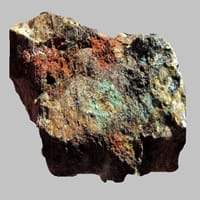Definition
Jasperoid is a rare, peculiar type of metasomatic alteration of rocks
Arkose is a sedimentary rock, specifically a type of sandstone containing at least 25% feldspar
Discoverer
Unknown
Alexandre Brongniart
Etymology
From silica, the main mineral content of Jasperoid
From Auvergne region of France used by a French geologist Alexandre Brongniart in 1826 who applied this term to some feldspathic sandstones
Class
Sedimentary Rocks
Sedimentary Rocks
Sub-Class
Durable Rock, Medium Hardness Rock
Durable Rock, Hard Rock
Group
Not Applicable
Not Applicable
Other Categories
Coarse Grained Rock, Fine Grained Rock, Medium Grained Rock, Opaque Rock
Coarse Grained Rock, Opaque Rock
Color
Black, Brown, Colourless, Green, Grey, Pink, White
Reddish Brown
Durability
Durable
Durable
Scratch Resistant
Yes
Yes
Appearance
Glassy or Pearly
Rough and Dull
Interior Uses
Decorative Aggregates, Floor Tiles, Homes, Interior Decoration
Decorative Aggregates, Homes, Interior Decoration
Exterior Uses
As Building Stone, Garden Decoration, Office Buildings, Paving Stone
Paving Stone, Office Buildings
Other Architectural Uses
Curbing
Whetstones
Construction Industry
As a Flux in the Production of Steel and Pig Iron, As a Sintering Agent in Steel Industry to process Iron Ore, As Dimension Stone, Cement Manufacture, for Road Aggregate, Making natural cement, Manufacture of Magnesium and Dolomite Refractories, Production of Glass and Ceramics, Serves as an Oil and Gas Reservoir rock
Cement Manufacture, Construction Aggregate, for Road Aggregate, Production of Glass and Ceramics, Raw material for the manufacture of mortar
Medical Industry
Taken as a Supplement for Calcium or Magnesium
Not Yet Used
Antiquity Uses
Artifacts, Jewellery, Monuments, Sculpture
Artifacts, Sculpture, Small Figurines
Commercial Uses
An Oil and Gas Reservoir, As a Feed Additive for Livestock, Gemstone, Metallurgical Flux, Production of Lime, Soil Conditioner, Source of Magnesia (MgO)
In aquifers, Soil Conditioner, Source of Magnesia (MgO), Tombstones
Types
Not Available
Not Available
Features
Host Rock for Lead, Traps for subsurface fluids like Oil and Natural Gas., Zinc and Copper Deposits
Available in Lots of Colors and Patterns, Generally rough to touch, Is one of the oldest rock
Archaeological Significance
Monuments
Used
Not Yet Used
Famous Monuments
Data Not Available
Not Applicable
Famous Sculptures
Data Not Available
Data Not Available
Pictographs
Used
Not Used
Petroglyphs
Used
Not Used
Formation
Jasperoid is a rare and peculiar type of metasomatic alteration of rocks. It is formed by extreme alteration of wall rocks within a shear zone which may occur in sediments, andesites, trachytes and basalts.
Arkose rock forms from the weathering of feldspar-rich igneous or metamorphic rock, most commonly granitic rocks, which are primarily composed of quartz and feldspar.
Mineral Content
Clay Minerals, Pyrite, Quartz, Sulfides
Calcite, Clay, Clay Minerals, Feldspar, Micas, Quartz
Compound Content
NaCl, CaO, Carbon Dioxide, Magnesium Carbonate, MgO
Aluminium Oxide, CaO, Iron(III) Oxide, Potassium Oxide, MgO, Sodium Oxide, Silicon Dioxide
Types of Metamorphism
Burial Metamorphism, Cataclastic Metamorphism, Regional Metamorphism
Not Applicable
Types of Weathering
Not Applicable
Biological Weathering, Chemical Weathering, Mechanical Weathering
Types of Erosion
Not Applicable
Coastal Erosion, Glacier Erosion, Water Erosion, Wind Erosion
Grain Size
Medium to Fine Coarse Grained
Coarse Grained
Fracture
Conchoidal
Conchoidal
Porosity
Less Porous
Highly Porous
Luster
Vitreous and Pearly
Dull
Compressive Strength
Not Available
Cleavage
Perfect
Not Available
Toughness
1
Not Available
Transparency
Transparent to Translucent
Opaque
Density
2.8-2.9 g/cm3
Not Available
Specific Heat Capacity
Not Available
Resistance
Heat Resistant, Pressure Resistant, Wear Resistant
Heat Resistant, Impact Resistant, Pressure Resistant
Deposits in Eastern Continents
Asia
China, India
China, India, Kazakhstan, Mongolia, Russia, Uzbekistan
Africa
Morocco, Namibia
Namibia, Nigeria, South Africa
Europe
Austria, Italy, Romania, Spain, Switzerland
Austria, Denmark, Germany, Great Britain, Netherlands, Norway, Poland, Sweden, Switzerland, United Kingdom
Others
Not Yet Found
Greenland
Deposits in Western Continents
North America
Mexico, USA
Canada, USA
South America
Brazil, Colombia
Brazil
Deposits in Oceania Continent
Australia
New South Wales, Queensland, Yorke Peninsula
New South Wales, New Zealand
All about Jasperoid and Arkose Properties
Know all about Jasperoid and Arkose properties here. All properties of rocks are important as they define the type of rock and its application. Jasperoid and Arkose belong to Sedimentary Rocks.Texture of Jasperoid is Earthy whereas that of Arkose is Clastic. Jasperoid appears Glassy or Pearly and Arkose appears Rough and Dull. The luster of Jasperoid is vitreous and pearly while that of Arkose is dull. Jasperoid is available in black, brown, colourless, green, grey, pink, white colors whereas Arkose is available in reddish brown colors. The commercial uses of Jasperoid are an oil and gas reservoir, as a feed additive for livestock, gemstone, metallurgical flux, production of lime, soil conditioner, source of magnesia (mgo) and that of Arkose are in aquifers, soil conditioner, source of magnesia (mgo), tombstones.










